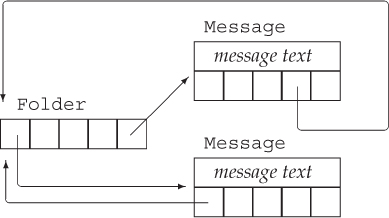 13.4. A Copy-Control Example
by Barbara E. Moo, Josée Lajoie, Stanley B. Lippman
C++ Primer, Fifth Edition
13.4. A Copy-Control Example
by Barbara E. Moo, Josée Lajoie, Stanley B. Lippman
C++ Primer, Fifth Edition
- Title Page
- Copyright Page
- Dedication Page
- Contents
- New Features in C++11
- Preface
- Chapter 1. Getting Started
- Part I. The Basics
- Contents
- Chapter 2. Variables and Basic Types
- Chapter 3. Strings, Vectors, and Arrays
- Chapter 4. Expressions
- Contents
- 4.1. Fundamentals
- 4.2. Arithmetic Operators
- 4.3. Logical and Relational Operators
- 4.4. Assignment Operators
- 4.5. Increment and Decrement Operators
- 4.6. The Member Access Operators
- 4.7. The Conditional Operator
- 4.8. The Bitwise Operators
- 4.9. The sizeof Operator
- 4.10. Comma Operator
- 4.11. Type Conversions
- 4.12. Operator Precedence Table
- Chapter Summary
- Defined Terms
- Chapter 5. Statements
- Chapter 6. Functions
- Chapter 7. Classes
- Part II. The C++ Library
- Contents
- Chapter 8. The IO Library
- Chapter 9. Sequential Containers
- Chapter 10. Generic Algorithms
- Chapter 11. Associative Containers
- Chapter 12. Dynamic Memory
- Part III. Tools for Class Authors
- Contents
- Chapter 13. Copy Control
- Chapter 14. Overloaded Operations and Conversions
- Contents
- 14.1. Basic Concepts
- 14.2. Input and Output Operators
- 14.3. Arithmetic and Relational Operators
- 14.4. Assignment Operators
- 14.5. Subscript Operator
- 14.6. Increment and Decrement Operators
- 14.7. Member Access Operators
- 14.8. Function-Call Operator
- 14.9. Overloading, Conversions, and Operators
- Chapter Summary
- Defined Terms
- Chapter 15. Object-Oriented Programming
- Contents
- 15.1. OOP: An Overview
- 15.2. Defining Base and Derived Classes
- 15.3. Virtual Functions
- 15.4. Abstract Base Classes
- 15.5. Access Control and Inheritance
- 15.6. Class Scope under Inheritance
- 15.7. Constructors and Copy Control
- 15.8. Containers and Inheritance
- 15.9. Text Queries Revisited
- Chapter Summary
- Defined Terms
- Chapter 16. Templates and Generic Programming
- Part IV. Advanced Topics
- Contents
- Chapter 17. Specialized Library Facilities
- Chapter 18. Tools for Large Programs
- Chapter 19. Specialized Tools and Techniques
- Appendix A. The Library
- Contents
- A.1. Library Names and Headers
- A.2. A Brief Tour of the Algorithms
- A.2.1. Algorithms to Find an Object
- A.2.2. Other Read-Only Algorithms
- A.2.3. Binary Search Algorithms
- A.2.4. Algorithms That Write Container Elements
- A.2.5. Partitioning and Sorting Algorithms
- A.2.6. General Reordering Operations
- A.2.7. Permutation Algorithms
- A.2.8. Set Algorithms for Sorted Sequences
- A.2.9. Minimum and Maximum Values
- A.2.10. Numeric Algorithms
- A.3. Random Numbers
- Index
- Add Pages
13.4. A Copy-Control Example
Although copy control is most often needed for classes that allocate resources, resource management is not the only reason why a class might need to define these members. Some classes have bookkeeping or other actions that the copy-control members must perform.
As an example of a class that needs copy control in order to do some bookkeeping, we’ll sketch out two classes that might be used in a mail-handling application. These classes, Message and Folder, represent, respectively, email (or other kinds of) messages, and directories in which a message might appear. Each Message can appear in multiple Folders. However, there will be only one copy of the contents of any given Message. That way, if the contents of a Message are changed, those changes will appear when we view that Message from any of its Folders.
To keep track of which Messages are in which Folders, each Message will store a set of pointers to the Folders in which it appears, and each Folder will contain a set of pointers to its Messages. Figure 13.1 illustrates this design.
Figure 13.1. Message and Folder Class Design
Our Message class will provide save and remove operations to add or remove a Message from a specified Folder. To create a new Message, we will specify the contents of the message but no Folder. To put a Message in a particular Folder, we must call save.
When we copy a Message, the copy and the original will be distinct Messages, but both Messages should appear in the same set of Folders. Thus, copying a Message will copy the contents and the set of Folder pointers. It must also add a pointer to the newly created Message to each of those Folders.
When we destroy a Message, that Message no longer exists. Therefore, destroying a Message must remove pointers to that Message from the Folders that had contained that Message.
When we assign one Message to another, we’ll replace the contents of the left-hand Message with those in the right-hand side. We must also update the set of Folders, removing the left-hand Message from its previous Folders and adding that Message to the Folders in which the right-hand Message appears.
Looking at this list of operations, we can see that both the destructor and the copy-assignment operator have to remove this Message from the Folders that point to it. Similarly, both the copy constructor and the copy-assignment operator add a Message to a given list of Folders. We’ll define a pair of private utility functions to do these tasks.
The copy-assignment operator often does the same work as is needed in the copy constructor and destructor. In such cases, the common work should be put in private utility functions.
The Folder class will need analogous copy control members to add or remove itself from the Messages it stores.
We’ll leave the design and implementation of the Folder class as an exercise. However, we’ll assume that the Folder class has members named addMsg and remMsg that do whatever work is need to add or remove this Message, respectively, from the set of messages in the given Folder.
-
No Comment
